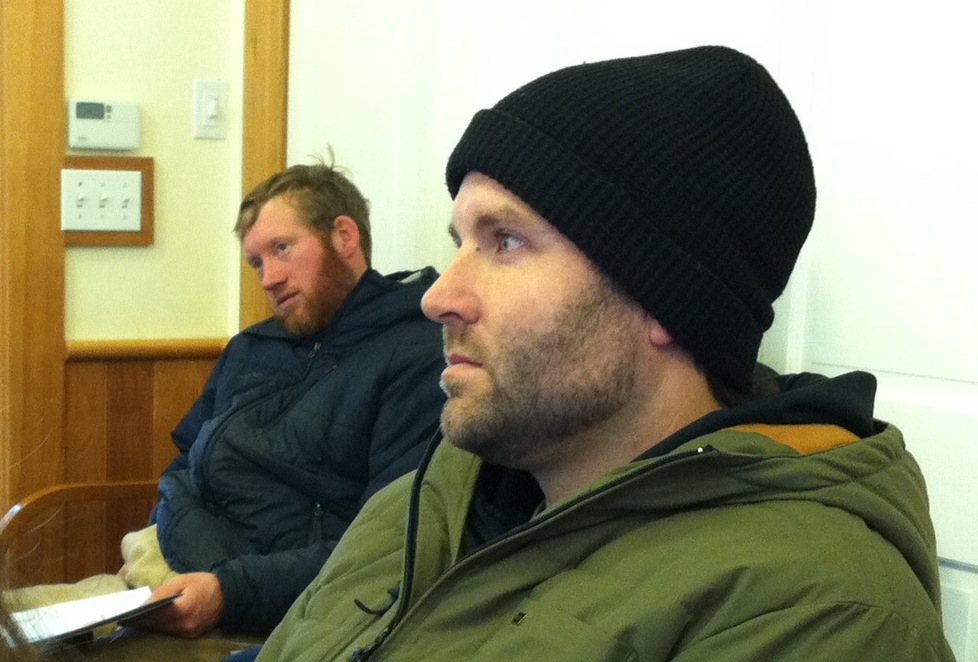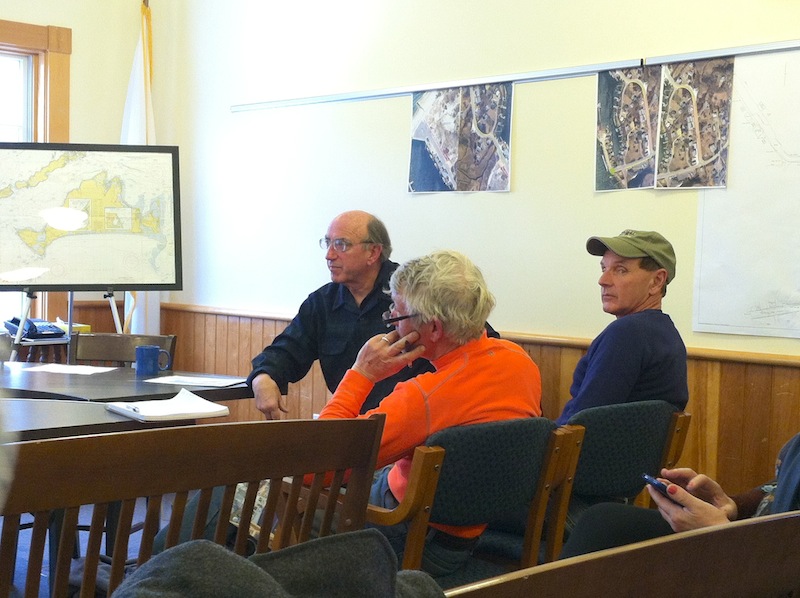A representative from Denmark’s largest energy company had a cold reception in Chilmark this week as commercial fishermen and others discussed a proposed wind farm south of the Vineyard.
Andy Revill, a fishermen’s liaison for Dong Energy, traveled from the U.K. to meet with fishermen in preparation for mapping a large area of the sea floor where the company plans to install up to 100 turbines. The 472-square-mile lease area begins 15 miles south of the Vineyard and extends diagonally to the southwest.

But even before plans can be drawn, the company will need to survey the area. A survey ship would operate day and night, towing a number of scientific instruments, some on the surface and some at depth, traveling back and forth at intervals of about 900 metres. Mr. Revill envisioned the survey lasting four weeks in May.
But fishermen who gathered at the Chimark town hall on Tuesday said that would almost surely interfere with gillnetters in the area.
How the project affects fisheries would be incorporated into a later environmental impact statement. The goal on Tuesday was simply to learn how mapping and fishing could happen simultaneously.
Dong (Danish oil and natural gas) Energy specializes in oil and gas exploration and production, but has built more wind farms than any other company to date. The Massachusetts project marked its entrance into the U.S. wind energy market. This week it also announced plans to take over a 250-square-mile lease area off the New Jersey coast.
Wes Brighton, a commercial fisherman out of Menemsha, said the area south of the Vineyard would be thick with fishing gear in May. He said each gillnetting boat would have between 10 and 20 nets, each one extending about three quarters of a mile on the sea floor. In July the area is habitat to crabs and lobsters.
To further complicate matters, Island fishermen tend to use the older Loran method of navigation, rather than latitude and longitude. But they also tend to leave space between their lines so mobile fishermen can get through. Mr. Revill asked if the surveyors could use the same system and avoid the nets, but Mr. Brighton said that could be a challenge, especially in bad weather.
He said a better time would be March, when the area closes to fishing. “That’s your best bet if you don’t want to get a hammer through your windshield,” he said.
Mr. Revill said March would be too soon in terms of planning, but he was confident the obstacles could be overcome. “You guys sent people to the moon, so I’m sure we can work this out,” he said.
“The moon would be a much better place for a wind farm,” replied Mr. Brighton.
The company plans to hire a local fisherman to join the survey mission and help avoid the fishing gear.
Former commercial fisherman Jonathan Mayhew suggested traversing the area diagonally to stay in line with the vessels using the Loran method, but Mr. Brighton said crisscrossing the area in both directions would still be a problem. “It’s corduroy this whole way up,” he said. “That would be catastrophic.”
Commercial fishermen in the region have generally opposed wind farm projects near the Vineyard, including Cape Wind, which was upended last year when it failed to meet a funding deadline and two energy companies severed their contracts. The former Martha’s Vineyard Dukes County Fishermen’s Association sued Cape Wind a few years ago, arguing that the project would disrupt commercial fisheries in Nantucket Sound. With legal fees piling up, the group eventually settled, but remerged last year as the Martha’s Vineyard Fishermen’s Preservation Trust, which helped organize the meeting on Tuesday. The group is now working to establish a permit bank and other strategies to support Island fishermen. Four of the nine board members were present on Tuesday.
Also present were Richard Andre and Erik Peckar of Vineyard Power, an Island-owned energy cooperative that has partnered with developer OffshoreMW to create a large wind farm just east of the area leased by Dong Energy. Mr. Andre also plans to consult with local fishermen when the time comes.
“All the same stuff has to be done,” he said.
The half dozen fishermen who attended the meeting offered measured support in terms of providing information, but were not enthusiastic about the proposal.
“One extreme is to do nothing,” Mr. Revill said after about 40 minutes of discussion. “Another extreme end is that we ask people not to fish there.” He seemed not to favor either option, but said the company was intent on surveying in May.
Chilmark selectman and trust board member Warren Doty noted that Island fisherman had no incentive to assist the company. And Mr. Brighton pointed out that legal action would likely result from damaged gear.
“If you lost the majority of your nets, you’re talking about 50, 60 grand worth of nets or more at a time,” he said. “So you could be sure that the majority of fishermen would probably be eager to fight for the damages.”
“It’s not our intention to destroy nets, destroy livelihoods,” Mr. Revill said. “We need to come up with a solution.”
Because gillnets are anchored to the bottom, one possible solution would be for the survey equipment to pass above them in the water.
Mr. Revill plans to meet with the National Marine Fisheries Service next week to get a sense of the federal requirements. Looking ahead, he said after construction begins, there would be a temporary closure, but that fishing could eventually continue. It may not be exactly the same as before, he said, but the fish would remain.
All sides seemed open about their ideas and concerns. At one point, Mr. Doty inquired about the nature of previous agreements between the company and fishermen. “Does the understanding ever involve money?” he asked. Mr. Revill said only that an agreement would be reached.
But the company will undoubtedly need the support of local fishermen. Mr. Revill hoped to get a handle on the situation this week.
“I know this whole area is important for fisheries,” he said. “It’s obvious that we can’t just go in there and do the survey. And you’ve told us that and it’s very clear, and that’s great. That’s what we wanted to hear.”







Comments (23)
Comments
Comment policy »